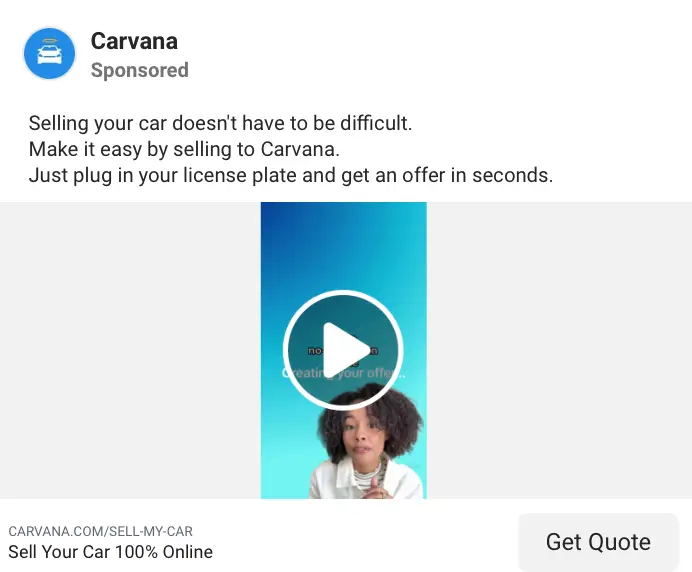
This display ad effectively targets car owners looking to sell by clearly communicating that the process is quick, easy, and can be done from home.
The message is instantly understandable, with a specific car model and dollar amount that add credibility and urgency.
The smiling, attractive person reinforces a positive emotional response, while the clean layout ensures everything remains highly visible—even on mobile.
Google Ads is a powerful tool for car dealerships—not only to attract buyers and sell vehicles, but also to reach motivated car owners looking to sell, helping dealerships source quality inventory at competitive prices.
Keywords: Sell Smarter, Buy Smarter with Google Ads
In the car dealership industry, the difference between a profitable campaign and wasted ad spend often comes down to targeting the right keywords.
Let’s break down the top-performing Google Ads keywords for dealerships and how to structure them to maximize both sales and sourcing.
Best Keywords to Attract Buyers
This is your go-to list for reaching ready-to-buy customers through Google Ads—maximize visibility, drive leads, and move inventory faster.
| Keyword | Monthly Search Volume (USA) |
|---|---|
| car dealerships near me | 1000000 |
| used cars near me | 550000 |
| cars for sale near me | 450000 |
| used car dealerships near me | 368000 |
| used cars for sale near me | 246000 |
| used car dealers | 201000 |
| car lots near me | 135000 |
| used car lots near me | 90500 |
| certified pre-owned cars | 60500 |
| best used cars to buy | 49500 |
| affordable used cars | 33100 |
| cheap cars for sale near me | 27100 |
| car dealerships open on Sunday | 27100 |
| car dealerships with no credit check | 22200 |
| car dealerships that accept bad credit | 14800 |
| used cars for sale by owner | 12100 |
| low down payment car dealerships | 12100 |
| no money down car dealerships | 9900 |
| in-house financing car dealerships | 8100 |
| car dealerships with low interest rates | 6600 |
| car dealerships offering rebates | 5400 |
| car dealerships with military discounts | 4400 |
| car dealerships with student discounts | 3600 |
| local car dealerships | 2900 |
| car dealerships with senior discounts | 2900 |
| car dealerships with trade-in deals | 2400 |
| car dealerships with cash back offers | 1900 |
| car dealerships with zero percent financing | 1600 |
| car dealerships with lease specials | 1300 |
| car dealerships with warranty programs | 1000 |
| car dealerships with service centers | 880 |
| car dealerships with loaner cars | 720 |
| car dealerships with shuttle service | 590 |
| car dealerships with online inventory | 480 |
| car dealerships with virtual tours | 390 |
| car dealerships with home delivery | 320 |
| car dealerships with contactless buying | 260 |
| car dealerships with mobile app | 210 |
| car dealerships with live chat | 170 |
| car dealerships with video consultations | 140 |
| car dealerships with bilingual staff | 110 |
| car dealerships with extended hours | 90 |
| car dealerships with weekend hours | 70 |
| car dealerships with holiday sales | 60 |
| car dealerships with clearance sales | 50 |
| car dealerships with special financing | 40 |
| car dealerships with credit repair services | 30 |
| car dealerships with referral programs | 20 |
| car dealerships with loyalty programs | 10 |
| car dealerships with price matching | 9 |
| car dealerships with free maintenance | 8 |
These terms reflect real purchase intent: people who want to test drive today, compare financing options, or find a reliable used car in their area.
These are the types of queries that bring customers to your lot—ready to sign.
Best Keywords to Attract Sellers
This is your essential list to attract motivated car owners looking to sell—helping your dealership acquire quality vehicles at the right price through targeted Google Ads.
| Keyword | Monthly Search Volume (US) |
|---|---|
| sell my car | 60500 |
| sell my car online | 22200 |
| sell car | 22200 |
| sell car online | 14800 |
| sell my car near me | 12100 |
| cash for cars | 9900 |
| sell used car | 8100 |
| sell car near me | 6600 |
| cash for junk cars | 6600 |
| sell my used car | 5400 |
| sell junk car | 5400 |
| sell your car | 4400 |
| sell my car fast | 4400 |
| where to sell my car | 3600 |
| sell my Toyota | 2900 |
| best place to sell car | 2900 |
| sell my junk car | 2900 |
| sell my Honda | 2400 |
| sell my car for cash | 2400 |
| sell my Ford | 1900 |
| sell old car | 1900 |
| sell my Chevrolet | 1600 |
| sell my car today | 1600 |
| sell car for cash | 1600 |
| sell my Nissan | 1300 |
| sell my car quickly | 1300 |
| car buyers near me | 1300 |
| sell my BMW | 1000 |
| sell my car instantly | 1000 |
| sell my Mercedes-Benz | 880 |
| sell my car for free | 880 |
| sell damaged car | 880 |
| sell my Lexus | 720 |
| sell my broken car | 720 |
| sell my car no title | 720 |
| sell my Subaru | 590 |
| sell my car for parts | 590 |
| sell my car without title | 590 |
| sell my Volkswagen | 480 |
| sell my financed car | 480 |
| sell car without title | 480 |
| sell my Audi | 390 |
| sell my car same day | 390 |
| sell my Hyundai | 320 |
| sell my car privately | 320 |
| sell my car for scrap | 320 |
| sell my Kia | 260 |
| sell my car with loan | 260 |
| sell my Jeep | 210 |
| sell my car for the best price | 210 |
| sell my Dodge | 170 |
| sell my car for cash near me | 170 |
| sell my Mazda | 140 |
| sell my car to a dealership | 140 |
| sell my GMC | 110 |
| sell my car with negative equity | 110 |
| sell my Chrysler | 90 |
| sell my car with outstanding finance | 90 |
| sell my Ram | 70 |
| sell my car with mechanical problems | 70 |
| sell my Buick | 60 |
| sell my car with body damage | 60 |
| sell my Cadillac | 50 |
| sell my car with high mileage | 50 |
| sell my Acura | 40 |
| sell my car with expired registration | 40 |
| sell my Infiniti | 30 |
| sell my car with salvage title | 30 |
| sell my Lincoln | 20 |
| sell my car with lien | 20 |
| sell my Volvo | 10 |
| sell my car with blown engine | 10 |
| sell my Tesla | 9 |
| sell my Land Rover | 8 |
| sell my Jaguar | 7 |
| sell my Porsche | 6 |
| sell my Mini | 5 |
| sell my Mitsubishi | 4 |
| sell my Fiat | 3 |
| sell my Alfa Romeo | 2 |
| sell my Genesis | 1 |
| sell my car in [City Name] |
You’ll notice many of these searches include a specific brand.
These are gold for dealerships: not only do they tell you what kind of vehicle the person is trying to sell, but they allow you to create hyper-relevant ad groups (and even landing pages) for sellers of Toyota, Ford, Honda, and beyond.
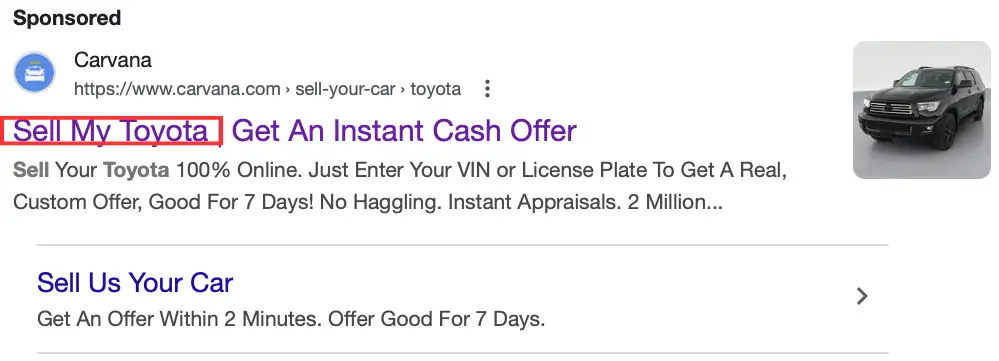
How to Categorize Your Keywords for Better Campaigns
The most successful dealerships split their campaigns into two distinct tracks: Sell-side and Source-side.
Sell-side campaigns should group keywords by buyer profile:
-
-
- Location-based intent: “used cars near me,” “car dealerships near me”
- Deal-focused: “no money down car dealerships,” “car dealerships with rebates”
- Financing concerns: “car dealerships with no credit check,” “in-house financing car dealerships”
-
Source-side campaigns should be segmented by:
-
-
- Urgency: “sell my car fast,” “sell my car today”
- Channel preference: “sell my car online,” “sell my car to a dealership”
- Brand specificity: “sell my Jeep,” “sell my Nissan,” “sell my BMW”
-
Pro Tip: Don’t run “sell” and “buy” keywords in the same campaign.
The audience intent is completely different, and mixing them will confuse Google’s algorithm—and waste your budget.
When executed right, keyword strategy for car dealerships does more than drive clicks—it aligns your inventory, pricing model, and customer experience with exactly what your audience is searching for.

Negative Keywords: Protect Your Budget from Bad Clicks
In the highly competitive auto industry, irrelevant clicks are not just annoying—they’re expensive.
Adding negative keywords to your campaigns ensures your ads don’t show for searches that will never convert, whether you’re selling cars or sourcing them. Here’s how to think about them in the dealership context.
a. Filter Out Job Seekers and Careers
Terms like “car dealership jobs,” “become a car salesman,” “dealership hiring near me,” and “auto finance careers” are common. Unless you’re recruiting, you don’t want to pay for those clicks.
Suggested negative keywords: jobs, careers, hiring, internship, employment
b. Avoid DIY and Educational Searches
Some users are just looking to learn or fix their own cars. Keywords like “how to sell a car,” “how to trade in my car,” or “used car price guide” show research intent, not transactional.
Suggested negative keywords: how to, guide, DIY, Kelley Blue Book, edmunds, price estimate
c. Exclude Wholesale, Auction, or B2B Terms
Unless you’re targeting fleet sales or auction deals, block out traffic from businesses, brokers, or wholesalers. They’re usually looking for bulk discounts or very specific transactions.
Suggested negative keywords: wholesale, auction, fleet, salvage, copart, IAAI
d. Brand Conflict or Manufacturer Intent
Sometimes users are looking for manufacturer-level services rather than a local dealership. Searches like “Ford corporate,” “Chevrolet headquarters,” or “BMW USA contact” aren’t likely to turn into dealership visits.
Suggested negative keywords: corporate, headquarters, USA, factory, OEM
Demographics & Audiences: Know Who You’re Talking To—and How to Reach Them
To run successful Google Ads campaigns in the car dealership space, understanding who is searching is just as critical as what they’re searching.
Demographic targeting gives you the power to filter out unqualified traffic and focus your budget on high-converting profiles—whether you’re trying to sell inventory or acquire it.
Let’s break down the core demographic profiles that matter most for dealerships in 2025—and how you can translate them into high-performing audience strategies inside Google Ads.
Who’s Looking to Buy?
Most car buyers fall within the 25–54 age range, but there are key differences within that bracket. Smart dealerships segment these buyers into realistic, behavior-driven profiles:
25–34 | First-Time Buyers & Credit-Conscious Millennials
Budget-conscious and mobile-first, they respond to ads highlighting affordability, flexible credit, and fast approval.
Typical searches: “no credit check car dealerships,” “cheap used cars near me.”
35–44 | Young Families Looking for Reliability
Looking for space, safety, and warranty-backed cars. Pre-owned SUVs and certified vehicles dominate.
Typical searches: “certified pre-owned SUV,” “cars with warranty.”
45–54 | Stability-Oriented Buyers
Financially stable, often buying second vehicles or upgrading from older ones.
Typical searches: “top rated used cars,” “dealerships with price matching.”
Gender tends to matter less than life stage, but women often initiate the car search—especially in family or trade-in contexts.
Who’s Looking to Sell?
Car sellers skew slightly older (35–65+) and are often going through life transitions—moving, retiring, or downsizing.
35–44 | Active Sellers with Branded Queries
Selling late-model vehicles they’ve outgrown. Motivated by trust and speed.
Searches include: “sell my Honda CR-V,” “trade in my SUV.”
45–64 | Pragmatic, Time-Sensitive Sellers
Owners of older or second cars. Respond well to straightforward, no-hassle messaging.
Searches: “cash for used cars,” “sell my car fast.”
65+ | Retirees Downsizing or Leaving Driving
Highly motivated, cautious, and looking for reassurance.
Searches: “sell car without hassle,” “local dealership that buys cars.”
From Demographics to Targetable Audiences
Now here’s where Google Ads gives you a serious edge: once you understand who your audience is, you can actually reach them based on behavioral signals, life events, and intent—not just keywords.
In-Market Audiences: Reach People Actively Shopping or Selling
These are users already researching products or services like yours.
For dealerships, high-performing in-market audiences include:
-
- Used Vehicles → Perfect for low-funnel buyers
- Auto Loans → Ideal for credit-sensitive shoppers
- Vehicle Resale → Great for sourcing inventory from sellers
Life Events: Target People at the Right Moment
Major life changes often trigger car buying or selling. Google allows you to target:
-
- Recently Moved → Often sell or buy based on location change
- New Parent → Usually prompts the switch to a safer or larger vehicle
- Retiring Soon → Often looking to downsize and sell a second car
These audiences are especially effective in Demand Gen and Performance Max campaigns, where emotion and timing drive clicks.
Custom Segments: Build Audiences Around Behavior
You can create your own segments based on keywords, URLs, or apps. For dealerships:
-
- Target users who’ve visited Carvana, KBB, or competitor websites
- Build lists around phrases like “how to sell my car,” “used cars under $15k,” “trade-in value calculator”
This lets you intercept buyers and sellers who are further along in their decision-making—before they search for a specific dealership.
Remarketing: Re-Engage and Convert
Segment your past visitors by behavior and retarget with tailored ads:
-
- Viewed your “Sell Your Car” page but didn’t submit a form
- Started a financing application but didn’t complete
- Browsed a specific VDP but didn’t convert
Use Display or Search remarketing to bring them back with messages like:
-
- “Still thinking of selling your Civic? Get a new quote today.”
- “Your pre-owned SUV is still in stock—schedule your test drive now.”
Geo-Audience Nuances: Not All ZIP Codes Behave the Same
Match targeting and messaging to local behavioral patterns:
-
- Urban ZIPs → Mobile-first buyers, lower down payments, more demand for compact cars
- Suburban ZIPs → Family-focused buyers, SUVs, trade-in-heavy
- Rural ZIPs → Truck inventory, high value on service and in-person visits
Use geo bid adjustments, custom ad copy, and ZIP-specific landing pages to align with each segment’s context.
Messaging That Converts: Say the Right Thing to the Right Seller or Buyer
In Google Ads for car dealerships, your message is the moment of truth. No matter how good your targeting or keyword strategy is, if your ad doesn’t speak directly to the buyer or seller’s current motivation, you’re invisible.
In a saturated space where most dealerships run lookalike ads with generic slogans, strong, tailored messaging is your unfair advantage.
When You’re Trying to Sell Cars
Car buyers in 2025 are overwhelmed with options. If your ad looks like every other dealership promising “Great Deals” or “Huge Inventory,” you’re going to blend in and bleed budget. The key is to match your positioning to their real concerns, not your internal priorities.
Most buyers aren’t looking for “the best dealership.” They’re looking for the easiest, safest, and smartest way to get a car that fits their life. Your messaging should reflect that.
Position around:
-
- Speed: “Drive away today with no credit check.”
- Simplicity: “We handle the paperwork—you just pick the car.”
- Financial flexibility: “$0 down, approval in 3 minutes.”
- Trust: “Certified pre-owned. 2-year warranty included.”
One-size-fits-all ads rarely work. You’ll want multiple ad variations tailored to buyer types:
-
- For first-time buyers: emphasize low down payments, financing without traditional credit, and guidance.
- For family buyers: stress safety, space, warranties, and reliability.
- For urban professionals: highlight hybrid options, delivery service, or mobile trade-in app features.
Always anchor your positioning in what makes your dealership different.
If you offer at-home test drives, free returns, or guaranteed trade-in values, say so in the headline. Don’t save it for the landing page.
When You’re Trying to Source Cars
This is where most dealerships miss the mark. While selling cars is competitive, sourcing cars from individuals is a messaging challenge in itself—because you’re speaking to a totally different mindset.
The person trying to sell their car is not excited. They’re busy. Maybe stressed. They want to offload, not shop.
Effective positioning focuses on:
-
- Instant clarity: “We’ll buy your [Toyota Camry] today for $14,200.”
- No hassle: “Skip the marketplace. No strangers. No showings.”
- Speed: “Get a cash offer in 90 seconds. No visit required.”
- Convenience: “We’ll pick up your car from your driveway.”
In this category, specificity outperforms slogans. Ads with a dollar figure and a real car model nearly always get more clicks than vague copy like “We Want Your Vehicle!”
Example: “2020 Nissan Rogue? Get up to $16,900. No dealership visit.”
Visuals matter, too. Use happy sellers, not glossy showroom shots. Use real numbers, not stock taglines. Let the seller feel that this is fast, fair, and human.

Bonus: Trust Builders for Both Sides
No matter who you’re targeting, certain trust cues boost performance across the board:
-
- “Rated 4.8 on Google with 1,400+ reviews”
- “Locally owned. Serving [City] since 1998.”
- “100% online—no visit required.”
- “Licensed buyer. Instant payment.”
In a market where shady dealership reputations still linger, trust is a differentiator. Add it to your messaging framework early and often.
In summary, winning car dealership messaging is not about being clever—it’s about being clear, credible, and specific to intent.
Whether you’re looking to sell or source, your ads should sound like they were written for one person, at one moment—because that’s exactly how they’re being read.
Campaign Types: The Right Format to Convert Buyers & Sellers
In the car dealership world, success with Google Ads doesn’t just come down to keywords—it hinges on using the right campaign types for the right audience.
Selling a car and sourcing one are completely different user journeys, and each requires its own campaign format, structure, and creative strategy.
Here’s a breakdown of the most effective Google Ads campaign types for dealerships in 2025—and how to use each one with precision.
Search Campaigns: Still the Top Performer for Intent
Search campaigns remain the highest-ROI campaign type for car dealerships. They’re ideal for both selling and sourcing because they capture high-intent users actively looking for a solution.
For buyers, use search ads to target specific queries like:
“used cars near me,” “affordable used SUVs,” “certified pre-owned cars with warranty.”
Create ad groups based on buyer profile (budget-conscious, family-oriented, eco-focused) and make sure your landing pages match the ad’s promise—whether that’s low down payments, no credit checks, or fast financing approvals.
For sellers, your search campaigns should focus on terms like:
“sell my car,” “cash for cars,” “sell my [brand] car near me.”
Always direct this traffic to a dedicated page with an instant offer tool or trade-in evaluation—not your inventory homepage.
Use negative keywords to avoid job seekers, researchers, and wholesale traffic. And separate your buyer and seller campaigns completely to keep the messaging clean and the data actionable.

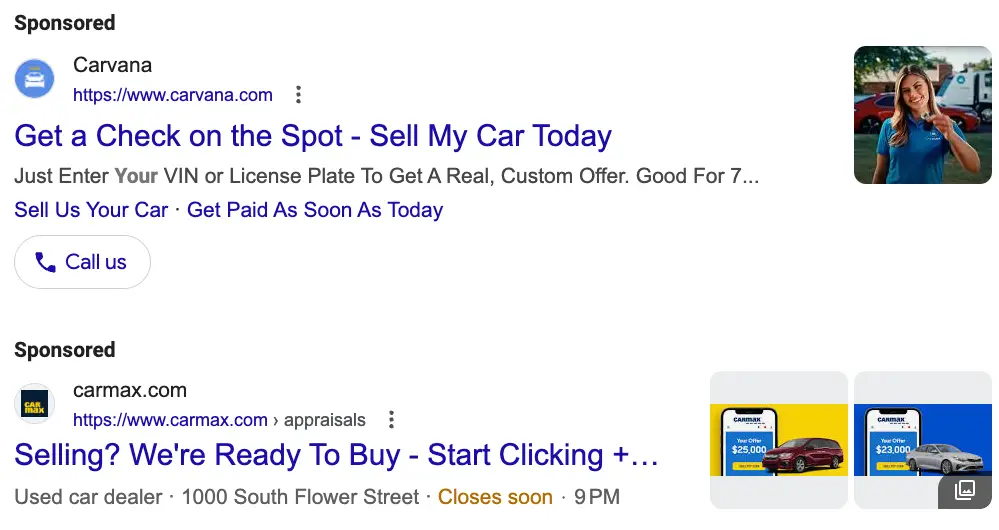
Search Ads are an effective way to attract private car owners looking to sell a wide range of vehicles, from nearly-new models to older trade-ins
Vehicle Listing Ads (VLAs): Instant Visibility for Your Inventory
Google’s Vehicle Listing Ads are the newest weapon in a dealership’s advertising arsenal.
These are dynamic Shopping-style ads built specifically for car dealerships—pulling inventory data (price, make, model, mileage, location) and showing it directly in Google Search and on the Cars tab.
Unlike standard Shopping campaigns, Vehicule Listing Ads are tailored for automotive and can connect directly to your inventory management system. They work exceptionally well for:
-
- Promoting high-demand models with competitive pricing
- Getting inventory in front of low-funnel buyers
- Driving conversions with vehicle-specific landing pages
To make the most of VLAs, ensure your vehicle feed is up to date, complete with high-quality images, competitive pricing, and accurate availability. Highlight your most marketable cars, not just everything on the lot.
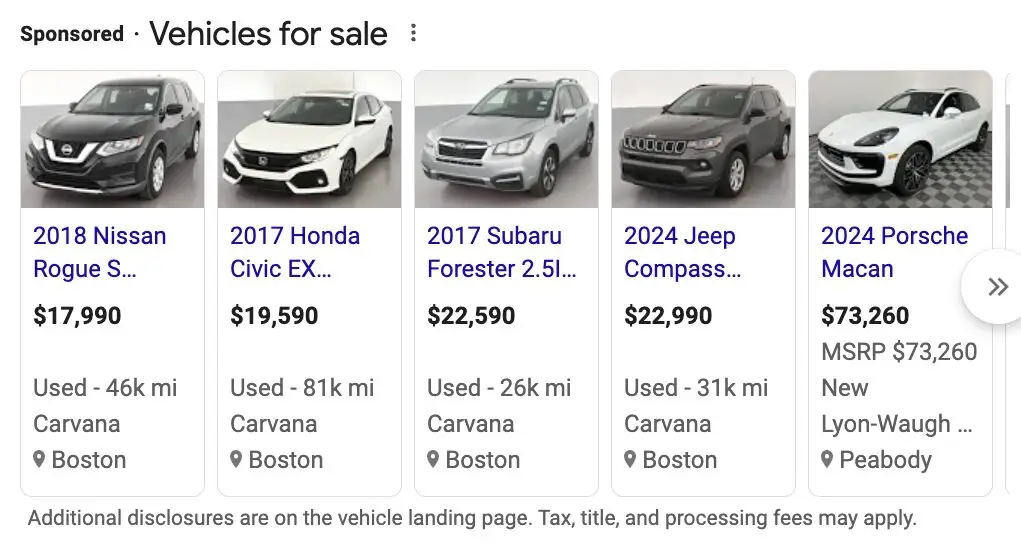
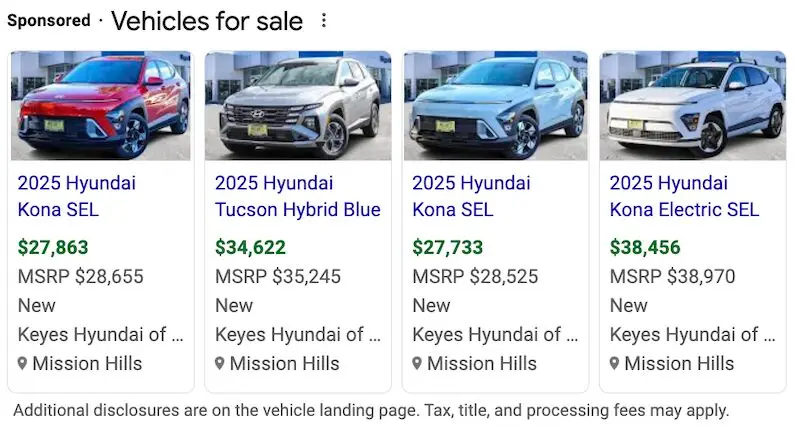
Performance Max: Great Reach—If You Control It
Performance Max can be powerful in the dealership context, but only if you feed it proper inputs. Many dealerships fail with PMax because they let it run on autopilot, generating fluff leads or blowing budget on branded search.
Use it effectively by:
-
- Building separate asset groups for buyers and sellers
- Feeding it high-quality creative (videos, lifestyle photos, strong CTAs)
- Uploading audience signals from past converters, lead lists, or website behavior
- Defining clear conversion goals: form fills, click-to-call, or trade-in starts
Where PMax shines is in running promotion-focused campaigns: clearance events, certified inventory pushes, or “Sell Your Car” week. But treat it as a complement to—not a replacement for—Search and VLAs.
Demand Gen: Plant the Seed for Future Sellers
Demand Gen (formerly Discovery) is the campaign type that lets you build mid-funnel awareness using bold visuals across Gmail, YouTube, and the Discover feed.
This is particularly useful for reaching:
-
- Owners of popular models (Toyota, Honda, Ford) who might be open to selling
- People in key life transitions: moving, downsizing, upgrading
- Audiences who’ve visited your “Sell My Car” pages but didn’t convert
Use custom segments (like people searching for car value estimators or selling tools), and focus messaging on speed and simplicity:
“Skip the hassle. Sell your car online, from home.”
These campaigns won’t convert instantly—but they warm up high-value seller leads and make your brand the first one they think of when they’re ready.

Hover over the image to zoom in
Video Campaigns: Build Trust and Visibility Before the Click
Standalone Video campaigns on YouTube are an underused but highly strategic option for car dealerships looking to build brand trust, drive local awareness, and nudge high-intent actions—especially in competitive metro areas where every dealership is bidding on the same search terms.
Unlike PMax or Demand Gen, standalone Video campaigns give you full control over targeting, messaging, and frequency, making them perfect for campaigns that require deliberate storytelling.
Where video excels for dealerships:
-
- Showcasing trust and professionalism before someone searches for you on Google
- Positioning your store as the go-to place to sell or buy, especially when competitors are dominating Search
- Reinforcing offline advertising (radio, billboard, direct mail) with consistent visual branding
How dealerships can use standalone Video campaigns effectively:
-
- Run “We Buy Cars” explainer videos showing the exact process: VIN input, instant offer, pickup, payment. Use real footage, not animations.
- Promote trade-in events or seasonal push campaigns (“Get $500 extra for your trade-in this weekend only”).
- Tell customer stories: Have real sellers or buyers explain how easy and fast the experience was—ideal for high-trust local messaging.
- Build long-term brand equity: A short 15-second ad showing your staff, your facility, and your offer helps future buyers recognize you when they finally do search.
Key best practices for dealership video campaigns:
-
- Use geotargeting within 10–30 miles of your lot to stay locally relevant
- Front-load your offer in the first 5 seconds—attention drops fast
- Use bumper ads (6-second) to reinforce your dealership name, website, or incentive offer between longer content
- Track view-through conversions, not just direct clicks—video often plays a supporting role that influences later search or website visits
Standalone video won’t replace Search, but it creates a familiarity moat around your brand—and in a market where trust drives both sales and sourcing, that moat is worth every dollar.
Now let’s analyze a series of videos from car dealerships promoting their car-buying services. We’ll break down the strengths and weaknesses of each one to understand what works—and what could be improved.
This Carvana video looks professional, but it takes 8 seconds to communicate the core value proposition—“Sell your car.” That’s far too long. The main message should come across within 3 seconds max to grab attention and keep viewers engaged.
On the contrary, this Carvana video follows the 3-second rule and clearly communicates the value proposition—“Selling your car 100% online”—within that timeframe. It also tells an engaging story, which is always a great way to keep viewers interested and emotionally connected.
This Carvana video is the best of the three—it hits the 3-second rule and delivers the value proposition right away, all while telling a fun, humorous story featuring two likable characters. It’s a scenario the average American can easily relate to, making it both engaging and effective.
In this video, the Canadian company Clutch gets it right by hitting the 3-second rule to clearly communicate the value proposition. It also features relatable, everyday scenes the average North American can connect with—like a couple standing in their kitchen or outside on a picturesque street as their car is picked up by the dealership. The fall setting adds a nice visual touch that reinforces the sense of familiarity and comfort.
And finally, we have this video by Webuyanycar USA. It’s very simple, highly repetitive, and slightly childish—but still remarkably effective at delivering the value proposition: “We buy any car at a good price for the customer, no trade-in required.” The playful jingle may not be sophisticated, but it’s catchy—and it ensures that both the song and the brand name stick in your memory.
Display: Re-engage, Don’t Spray
Display campaigns in auto retail are best reserved for retargeting, not cold reach. A common mistake is using display to broadcast “inventory” to uninterested general audiences.
Instead, use it to re-engage:
-
- Visitors who checked out a specific car model but didn’t act
- People who started a trade-in evaluation or finance application
- Users who visited your “we buy cars” section but bounced
Your creative should speak directly to their last action:
“Still interested in that 2020 RAV4? Schedule your test drive today.”
“Get a new offer for your 2016 Honda Civic—valid for 3 more days.”
Keep the frequency tight (3–5 impressions per user per week) and cap it after 14–21 days to avoid ad fatigue.
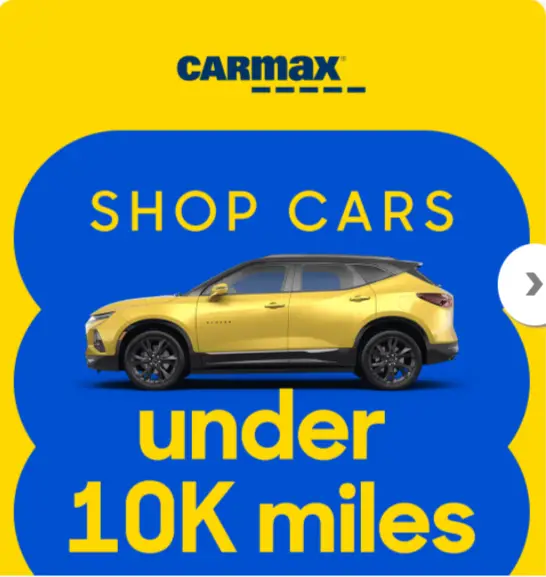
What Content Should Your Ads Include? Real-World Creatives That Convert
You can have perfect targeting and the right campaign type, but if your ad content doesn’t hit the right emotional and informational notes, you’ll lose to the dealership down the street.
In automotive, where buyers and sellers are overwhelmed by options, your creative needs to do three things instantly: build trust, highlight urgency, and remove friction.
Here’s how to craft each component of your ad—from headlines to extensions—specifically for a dealership looking to sell and source vehicles in 2025.
Headlines: Specific > Clever
Your headline is what gets you in the door. Generic lines like “Great Deals on Used Cars” are dead space. You need precision.
For buyers, focus on:
-
- Price or deal clarity: “Used SUVs from $189/month”
- Inventory urgency: “Certified Toyota RAV4s—Only 3 Left in Stock”
- Friction removal: “No Credit? No Problem. Get Approved Today”
For sellers, go hyper-targeted:
-
- “We’ll Buy Your Toyota Today for Up to $18,900”
- “Sell Your Car Online—Free Pickup in [City]”
- “Cash Offer in 90 Seconds—Any Make, Any Condition”
Localizing the headline (using ZIP code or city name) typically improves CTR by 15–30%.
Descriptions: Clarify the Process, Build Confidence
This is where you remove doubt and make the user feel like taking action is easy and risk-free.
For car buyers:
-
- “Get pre-approved in minutes. No SSN required.”
- “Test drive from home. We’ll bring the car to you.”
- “All cars come with 2-year powertrain warranty.”
For sellers:
-
- “Instant online appraisal. No visit required.”
- “We handle DMV paperwork. Paid same day.”
- “No lowball offers. Transparent pricing from day one.”
Make it feel like your dealership is professional, fast, and fair—without sounding robotic.
Image & Video: Real People, Real Cars, Real Emotions
Forget stock photos and overly polished showroom shots. Use lifestyle visuals that feel authentic.
Images
-
- For buyers: show real cars on real roads, ideally with people in them—families in SUVs, young professionals in sedans, etc.
- For sellers: use imagery of a happy customer handing off keys or a smartphone showing a cash offer screen.
Video
Short-form videos (6–15 seconds) perform best. For buyers:
-
- A quick walkthrough of a popular vehicle with price overlay
- A staff member speaking casually about financing options or new arrivals
For sellers:
-
- A screen recording of how fast and easy it is to get an instant quote
- A short testimonial of someone who sold their car to your dealership
Captions and bold on-screen text are essential—most users won’t listen with sound.
Extensions: Multiply the Reasons to Click
Using extensions correctly can double the amount of space your ad takes up—and double your chance of getting the right user to act.
Sitelink Extensions
Use for high-intent pages like:
-
- “View All Used Inventory”
- “Get Pre-Approved Now”
- “Sell Your Car”
- “Book a Test Drive”
Each sitelink should go to a dedicated page, not a general homepage.
Callout Extensions
These are perfect for trust builders and incentives. Examples:
-
- “Locally Owned Since 2006”
- “Instant Cash Offers Available”
- “No Down Payment Required”
- “Free 2-Year Warranty on All CPO Cars”
Structured Snippets
Great for listing car types or services. Use headers like:
-
- Models: “Civic, Camry, Elantra, CR-V”
- Services: “Trade-In Appraisal, Online Financing, Home Delivery”
Location Extensions
Essential for local dealerships. Include open hours and make sure your Google Business Profile is up to date so the location data stays accurate.

Image Extensions
These complement headlines visually and are especially powerful on mobile. Use lifestyle car images, not dealership logos or banners.

Price Extensions
Ideal for showcasing a few specific deals or vehicles:
-
- “2019 Camry—$17,800”
- “Certified CR-V—$289/mo Lease”
Price extensions should reflect actual inventory and match what’s on your landing page.
Lead Form Extensions
Great for sourcing campaigns or pre-approvals. Use for:
-
- “Get a Cash Offer for Your Car”
- “Apply for Financing in 30 Seconds”
Keep forms short: name, contact, and VIN or car model is often enough to qualify the lead.
Call Extensions
Use during dealership hours to capture intent from mobile searchers. Set them to show only during open hours and link to a direct sales or sourcing contact—don’t send to a general front desk line.
Promotion Extensions
Leverage these for specific time-bound incentives like:
-
- “Memorial Day Sale—$1,000 Bonus on All Trade-Ins”
- “This Week Only: 0% APR on All Used SUVs”
They add urgency, increase CTR, and work well with remarketing campaigns.
Landing Page: The Deal-Closer Your Ads Can’t Do Without
No matter how well-targeted your campaigns are, your landing page is where revenue is made—or lost. For car dealerships running Google Ads in 2025, the landing page should never be an afterthought. It’s not just a destination; it’s a sales tool.
Whether you’re looking to sell inventory or source vehicles from private owners, your landing page needs to do one thing exceptionally well: convert intent into action, fast.
Here’s how to structure and tailor high-converting landing pages for each side of your dealership’s business.
For Selling Cars: Focus on Reassurance, Inventory, and Easy Steps
When someone clicks on an ad like “Certified Pre-Owned SUVs – $0 Down,” they expect to land somewhere that makes it easy to find, trust, and start buying a car.
Your page should include:
-
- Dynamic inventory above the fold: If you advertised a CR-V or Camry, show them right away—with filters that match the ad (body type, monthly price range, financing options).
- Clear, short explanation of why your dealership: “Serving [City] since 2008,” “Rated 4.8/5 with 1,200+ reviews,” “Free 2-Year Warranty Included.”
This goes just under the hero section—no long blocks of text.
-
- Instant pre-approval or financing calculator: Let users input basic details and see what they might qualify for without full applications.
- Live chat or SMS option: Especially for mobile users who aren’t ready to call or fill out a form but have questions.
- Trust symbols: Include security badges, financing partners, and third-party review scores.
Every section should answer the question: “Why should I buy here instead of continuing to browse?”
Avoid bloated homepage layouts. The page should focus exclusively on the offer or category featured in the ad—like “Affordable Pre-Owned Cars Under $20K.”
For Sourcing Cars: Simplicity, Speed, and Specificity
If you’re running ads like “Sell Your Car Online – Free Pickup in [City],” your landing page must immediately validate three things:
This is real, this is fast, and this is easy.
What to include:
-
- VIN lookup or instant appraisal tool right at the top: If a user can’t immediately start getting their offer, you’ll lose them. Ask for as little as possible to start (license plate, ZIP code, or model/year).
- Step-by-step visual of the process:
1.Enter your car details
2.Get an instant offer
3.Schedule pickup
4.Get paid on the spot
This reduces anxiety and communicates control.
-
- Testimonials or proof: Real screenshots of offers, happy sellers, and short quotes like “I sold my car in 48 hours without leaving home.”
- FAQ dropdowns about titles, payments, inspections, etc.
- Geo-targeted trust cues: “We buy cars in [City] every day”—with a short paragraph or stat about how many local owners sold through you last month.
- Call to action at every scroll depth: Button to “Get Your Offer Now” or “See What Your Car is Worth” should appear multiple times, especially on mobile.
This is not the time for long-form dealership bragging. Keep everything focused on value to the seller: convenience, speed, and a fair offer.
One Page, One Goal
Don’t try to serve multiple intents with one landing page. If someone clicked on an ad for “Sell Your Car Online,” don’t also pitch them to browse your used inventory.
Likewise, a user interested in “Used SUVs Under $25K” doesn’t need to see messaging about trade-ins or vehicle sourcing.
Every landing page should be ad-specific, goal-specific, and friction-free.
The best dealership landing pages in 2025 aren’t just beautiful—they’re ruthlessly focused on what the user came to do. Every section earns its spot. Every form is lightweight. Every message aligns with the ad that brought them there.
Because in digital retail—especially in automotive—the first few seconds decide everything.
Let’s analyze Carvana’s landing page for car sellers—the one visitors see right after clicking on a Google ad
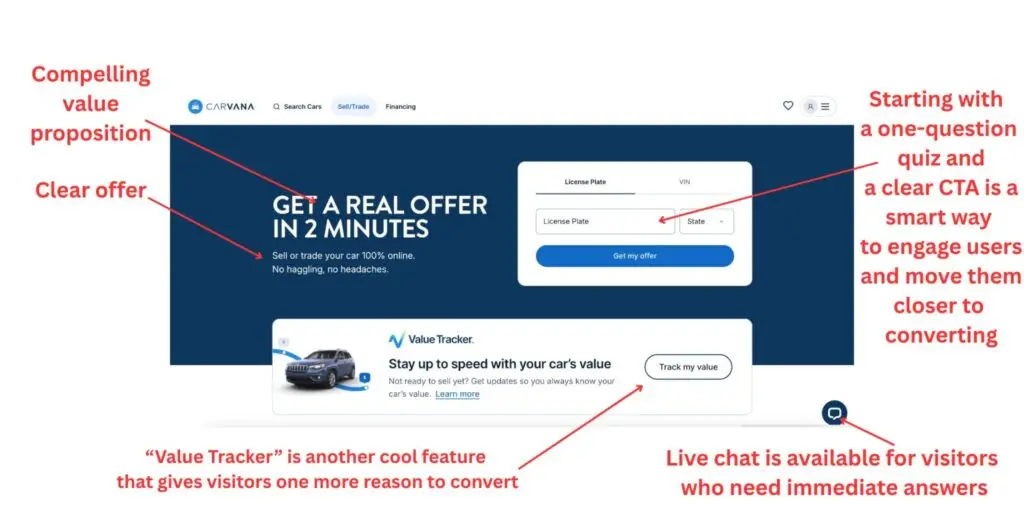
Hover over the images to zoom in
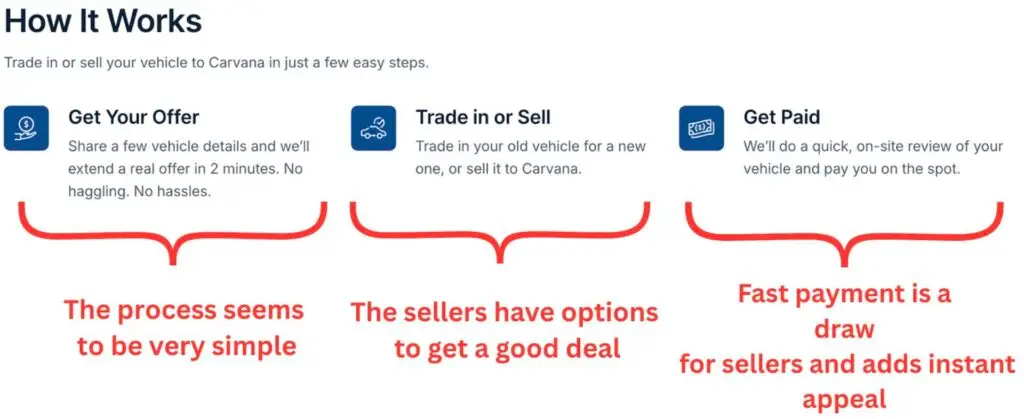
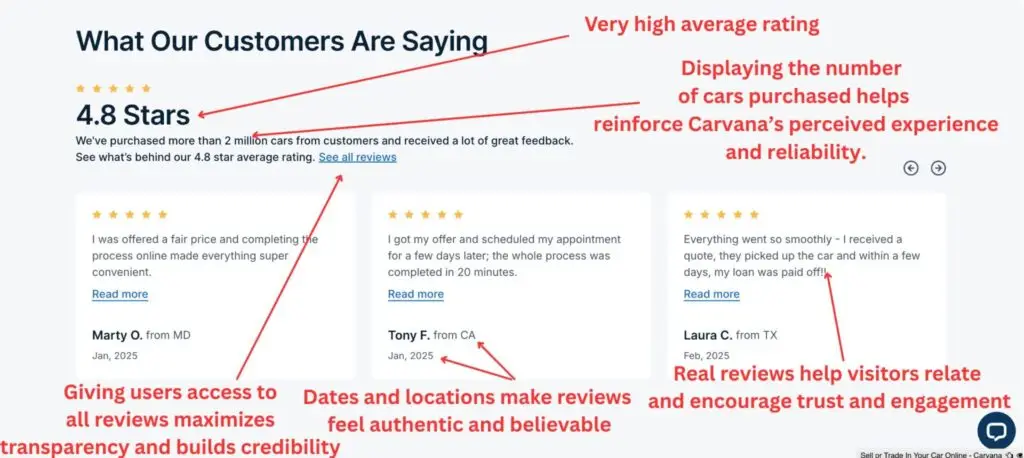
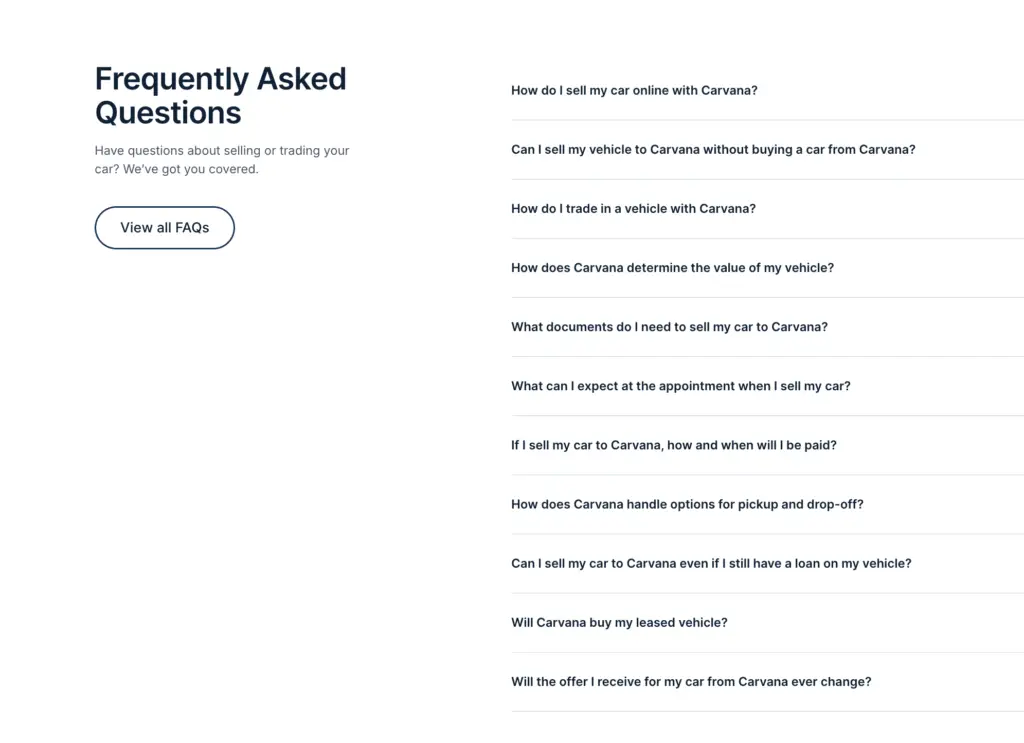
Carvana includes an FAQ on its landing page to address seller objections and even uses it to create urgency—like highlighting the 7-day limit on offers.
Landing page you can find at www.carvana.com/sell-my-car
Real-Life Success Stories: How Dealerships Grew with Google Ads
Google Ads has proven to be a powerful tool for dealerships looking to attract local buyers, increase test drives, and boost vehicle sales. Below are three real-life examples of car dealerships that effectively leveraged Google Ads to achieve remarkable results:
Audi Denver: Boosting New Car Sales with Dynamic Search Ads
Audi Denver, a luxury car dealership, was looking to increase new car sales while maximizing the relevance of their Google Ads. To achieve this, they implemented Dynamic Search Ads (DSAs), which automatically generated tailored headlines and descriptions based on their inventory feed and customer search queries.
• Strategy: Audi Denver used DSAs to match their available inventory with customer search intent in real-time. For instance, if a customer searched for “Audi Q5 lease deals in Denver,” the ad dynamically showed information about in-stock Audi Q5 models, including lease pricing and availability.
• Results: By focusing on dynamic ads that displayed the most relevant vehicles to local buyers, Audi Denver saw a 25% increase in lead volume and a 20% reduction in cost-per-lead (CPL). The increased relevance of the ads helped capture high-intent leads, directly leading to more showroom visits and test drives.
Toyota of Orlando: Driving Test Drives with Local Inventory Ads
Toyota of Orlando, a high-volume dealership, wanted to boost test drives and foot traffic to their showroom by targeting local buyers actively searching for vehicles. They utilized Local Inventory Ads (LIAs) to show available inventory to nearby customers in real-time.
• Strategy: Toyota of Orlando displayed LIAs that showcased specific vehicles in stock, allowing potential buyers to see current availability and visit the dealership. Their ads featured relevant details like price, promotions, and a call-to-action to “Visit the dealership today for a test drive.” Toyota also geo-targeted their ads to people within a 30-mile radius, ensuring that only local buyers saw the ads.
• Results: The LIA campaign led to a 40% increase in test drive appointments during the first month. Toyota of Orlando also reported a 15% increase in foot traffic, as customers responded positively to seeing in-stock cars and the convenience of visiting a nearby dealership.
Honda of Kirkland: Maximizing Lead Conversions with Video Ads
Honda of Kirkland sought to differentiate itself from competitors by creating an engaging video ad campaign that highlighted their dealership’s top-rated customer service and attractive financing options for new vehicles. They used YouTube video ads as part of their Google Ads strategy to drive lead conversions.
• Strategy: The dealership produced short, 30-second video ads showcasing their latest Honda models and promoting “0% financing for 60 months” on select vehicles. The ads featured a virtual walkthrough of their showroom, customer testimonials, and a clear call-to-action to “Schedule a test drive today.” They geo-targeted their video ads to local audiences actively searching for new vehicles.
• Results: Honda of Kirkland’s video ads campaign achieved a 25% increase in conversions, with more customers filling out lead forms and scheduling test drives directly from the video ads. The dealership also saw a 12% reduction in cost-per-conversion, making the campaign both effective and efficient.
These examples illustrate how car dealerships can successfully utilize various Google Ads formats—Dynamic Search Ads, Local Inventory Ads, and Video Ads—to boost leads, drive foot traffic, and increase sales. By tailoring campaigns to match inventory availability and local buyer intent, dealerships can significantly improve their ad performance and conversion rates.
The Cost of Google Ads for Dealerships: What You Should Really Expect in 2025
Let’s be clear: Google Ads is not cheap for car dealerships—but it’s also not supposed to be. You’re operating in one of the most competitive local service categories online, where each lead has high purchase intent and high lifetime value.
The key isn’t avoiding cost—it’s understanding where your money goes, what a lead is truly worth, and how to avoid wasting budget on irrelevant clicks.
Here’s a realistic look at what Google Ads will cost your dealership in 2025, broken down by campaign objective, location, and funnel stage.
Cost Per Click (CPC): You’re Paying for High Intent
In the dealership space, most CPCs fall between $2 and $8, but in major metros or with highly competitive keywords, it’s not unusual to see CPCs hit $12–$20+—especially on search terms like:
-
- “buy here pay here near me”
- “used cars under $20k”
- “sell my car today”
CPCs are highest for:
-
- Bottom-funnel keywords like “used car dealership near me” (very commercial, high competition)
- Geo-modified branded keywords (e.g., “Toyota dealer [city]”), which often trigger competitor bidding wars
However, high CPC doesn’t necessarily mean high cost per lead—if your conversion rates are strong and your landing pages are optimized, a $15 click can easily turn into a $1500 gross profit.
Cost Per Lead (CPL): Depends on Intent and Offer Type
For most car dealerships, average CPLs tend to land in the following ranges:
-
- Vehicle buyers: $40–$120 per qualified lead
- Private sellers (vehicle sourcing): $30–$90 per appraisal or quote request
- Finance or pre-approval leads: $50–$150 depending on the quality of the lead and the financing options promoted
You’ll often pay less to source a car than to sell one—because fewer dealerships run sourcing campaigns and there’s less competition on those keywords.
But sourcing leads tend to have lower conversion predictability, so you’ll need strong follow-up processes in place.
Budget Benchmarks by Dealership Size
Your monthly Google Ads spend should reflect your sales volume, inventory turnover, and profit margins. In 2025, here’s a rough range:
-
- Small dealerships (30–50 cars in stock):
$1,500–$3,000/month targeting local search + sourcing campaigns
-
- Mid-size dealerships (50–150 cars):
$3,000–$7,500/month across Search, Vehicle Listing Ads, and Performance Max
-
- Large dealers/multi-location groups:
$10,000–$25,000+/month including branding, lead gen, remarketing, and local conquesting
Most dealerships can see positive ROI starting at $100/day, provided campaigns are well-segmented and conversion tracking is reliable.
Where Dealerships Waste Budget (and How to Avoid It)
Wasted spend often hides in:
-
- Broad match keywords like “cars” or “used”, which attract unqualified clicks
- Untested Performance Max campaigns that over-prioritize branded search
- Display ads running wide-open without targeting exclusions
- Sending traffic to generic homepages instead of offer-specific landing pages
Also, many dealerships burn budget retargeting low-intent users or failing to exclude job seekers, DIY researchers, and B2B wholesale traffic.
That’s why investing in negative keyword lists, audience exclusions, and conversion data hygiene is just as important as your bid strategy.
What About Management Fees?
If you’re working with an agency or freelancer, expect to pay:
-
- 10%–20% of ad spend as a management fee, or
- A flat monthly retainer (commonly $500–$2,000 depending on scope)
Some agencies bundle creative and landing page support into the fee, while others charge separately.
The important thing is to ensure that your partner isn’t just reporting impressions—but optimizing for actual leads and profit per vehicle sold or sourced.
Synergy Between Google Ads and Facebook Ads: A Competitive Edge for Dealerships
For car dealerships, pairing Google Ads with Facebook Ads isn’t just a smart move—it’s a market-dominating strategy.
When properly coordinated, these platforms don’t compete; they reinforce each other across the buying and selling journey. One captures high-intent leads. The other builds intent before your competitors are even in the picture.
In a high-ticket, trust-sensitive industry like auto retail, this cross-channel synergy often means the difference between being the dealership they scroll past and being the dealership they remember when they’re ready to act.
Use Google to Close the Buyers, Facebook to Warm Them Up
Most car buyers don’t start their journey on Google—they start on Facebook or Instagram. They’re scrolling when they see a well-timed ad for “Used SUVs under $25K with 2-Year Warranty in [City].” They’re not searching yet, but you’ve just planted a seed.
Then, a few days later, they hit Google with searches like:
-
- “best used car dealerships near me”
- “Mazda CX-5 2020 certified pre-owned”
- “trade-in bonus for old car”
That’s where your Google Ads close the loop. If your name is the one they recognize from Instagram or Facebook, your click-through rate goes up, and your cost per acquisition goes down.
This is funnel stacking—and dealerships that only rely on Google are missing the top half.
To do this right:
-
- Run inventory-based Facebook ads to promote specific vehicles or categories (SUVs, hybrids, 3rd-row seating, etc.)
- Match your Google campaigns to those same offers, using branded language like “Trade-In Boost Event” or “Buy from Home Program”
Now you’re not just showing up—you’re showing up familiar.
Use Facebook to Source Cars That Aren’t Even Listed Yet
Car owners thinking about selling don’t always search “sell my car” right away. But they do browse Facebook Marketplace, look at dealership pages, or click on trade-in bonus ads.
Facebook lets you reach these pre-intent sellers before they ever land on Google.
Here’s how dealerships use Facebook to source inventory:
-
- Target by vehicle ownership (e.g., Honda Civic owners in your radius)
- Run Lead Ads offering “Free Online Appraisal in 90 Seconds”
- Highlight benefits like “We Pick Up. You Get Paid. No Dealership Visit.”
Then, once they engage—even if they don’t submit their VIN—you can follow up via:
-
- Google Display remarketing
- Search ads for “instant offer for my car” and “dealerships that buy cars near me”
You’re staying top of mind from curiosity to conversion. Plus, Facebook sourcing campaigns often generate leads for 30–50% less cost than Google when it comes to private sellers.
Geo Dominate Your Territory by Mirroring Campaigns
Let’s say you’re running Google Ads for “Used Cars in Dallas.”
Take that same campaign theme—price point, inventory selection, trade-in perks—and mirror it on Facebook and Instagram, but with video tours, carousel ads, and dealer branding.
Now users in your area see you in:
-
- Search results (“Toyota dealer near me”)
- YouTube prerolls (“Watch how easy it is to sell us your car”)
- Facebook feeds (“3rd-row SUVs under $25K available now”)
Dealerships doing this aren’t just getting seen. They’re creating the impression that they own the local market.
This multiplies brand recall and increases conversion rates across both platforms.
Retarget Google Traffic Through Facebook—But Do It Right
Instead of letting high-intent Google visitors disappear, retarget them with highly personalized Facebook ads:
-
- If they visited a vehicle detail page but didn’t call or convert, serve them a carousel of similar cars, or an ad like “Still thinking about the 2021 RAV4? 0% APR until Sunday.”
- If they visited your Sell Your Car page but didn’t complete the appraisal, run a Facebook retargeting ad offering “$500 Trade-In Bonus This Week Only.”
But make sure your creative doesn’t feel like a generic dealership ad. Speak directly to their last action. Mention the brand, model, or deal they showed interest in.
Dealers who do this see double-digit increases in return visits and conversions compared to dealerships running disconnected campaigns.
Unified Creative = More Conversions
One mistake many dealerships make is running separate ad strategies on Google and Facebook—different visuals, different CTAs, different offers. It confuses customers and dilutes your message.
Instead:
-
- Use the same offer across platforms (e.g., “Sell Your Car from Home in 3 Easy Steps”)
- Show the same vehicle inventory in both Google Vehicle Listing Ads and Facebook Carousel Ads
- Reinforce the same visual identity (same logos, colors, photo style, and tone of voice)
This consistency builds trust—and trust sells cars.
